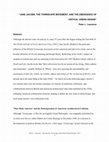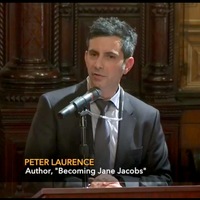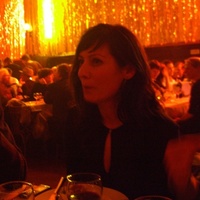Books by Peter L Laurence

Histories of Architecture Education in the United States, 2024
Histories of Architecture Education in the United States is an edited collection focused on the p... more Histories of Architecture Education in the United States is an edited collection focused on the professional evolution, experimental and enduring pedagogical approaches, and leading institutions of American architecture education. Beginning with the emergence of architecture as a profession in Philadelphia and ending with the early work, but unfinished international effort, of making room for women and people of color in positions of leadership in the field, this collection offers an important history of architecture education relevant to audiences both within and outside of the United States. Other themes include the relationship of professional organizations to educational institutions; the legacy of late nineteenth-century design concepts; the role of architectural history; educational changes and trans-Atlantic intellectual exchanges after WWII and the Cold War; the rise of the city and urban design in the architect’s consciousness; student protests and challenges to traditional architecture education; and the controversial appearance of environmental activism. This collection, in other words, provides a relevant history of the present, with topics of concern to all architects studying and working today.

BECOMING JANE JACOBS
Peter L. Laurence
University of Pennsylvania Press, 2015
Jane Jacobs is uni... more BECOMING JANE JACOBS
Peter L. Laurence
University of Pennsylvania Press, 2015
Jane Jacobs is universally recognized as one of the key figures in American urbanism, and The Death and Life of Great American Cities, which she wrote between 1958 and 1961, is considered one of the most important books on cities. Becoming Jane Jacobs is an intellectual biography focusing on Jacobs’s early life and writing career leading up to her great book, and offering a new foundation for not only understanding Death and Life but her subsequent books on cities, economies, and civilizations.
As the legend goes, Jacobs, a housewife, single-handedly took on Robert Moses, New York City's powerful master builder, and other city planners who sought first to level her Greenwich Village neighborhood and then to drive a highway through it. Jacobs’s most effective weapons in these David-versus-Goliath battles, and in writing her book, were her powers of observation and common sense. Becoming Jane Jacobs shows that what is missing from such discussions and myths about Jacobs is a critical examination of how she arrived at her ideas about city life. The book shows that although Jacobs had only a high school diploma, in the 1930s and 40s, she pursued a writing career that well prepared her to become an architectural critic just as postwar urban renewal policies came into effect. In the 1950s, at Architectural Forum, Jacobs was then immersed in an elite intellectual community of architects and urbanists that included editor Douglas Haskell, shopping mall designer Victor Gruen, housing advocate Catherine Bauer, architect Louis Kahn, Philadelphia city planner Edmund Bacon, urban historian Lewis Mumford, urban theorist Kevin Lynch, and the British writers at The Architectural Review. Through her work at Forum and these associations, Jacobs’s knowledge of and writing on suburban development and urban redevelopment grew and evolved; and she contributed significantly to the changing fields of architectural criticism and urban design, participated in important academic conferences, and became known as an expert writer on cities even before she started writing Death and Life.
With a consideration of Jacobs’s writing career in its historical context, and through the analysis of many unknown writings, Laurence asserts that Death and Life was not the spontaneous epiphany of an amateur activist but the product of a professional writer and experienced architectural critic with deep knowledge about the renewal and dynamics of American cities.
Peter L. Laurence teaches architectural and urban design, history, and theory and is director of graduate studies at Clemson University School of Architecture.
www.becomingjanejacobs.com
http://amzn.com/0812247884
"Developed with input from attendees of the Re-Imagining Cities: Urban Design After the Age of Oi... more "Developed with input from attendees of the Re-Imagining Cities: Urban Design After the Age of Oil conference, The Penn Resolution: Educating Urban Designers for Post-Carbon Cities is a richly illustrated roadmap to guide 21st century urban design education. The book can be viewed and downloaded below.
The Penn Resolution highlights the challenges posed by changing climate patterns and diminishing supplies of inexpensive oil and outlines the skills that both new and practicing urban designers will need to meet these challenges. Its inventive integration of text and imagery — apt quotations, exemplary projects — illustrates the translation of the principles into new ideas, approaches, and connections. An essay places the book in historical context, discussing the use of manifestos throughout the history of urban design."
Dissertations and Theses by Peter L Laurence
The first draft of BECOMING JANE JACOBS, University of Pennsylvania, 2009. This document is provi... more The first draft of BECOMING JANE JACOBS, University of Pennsylvania, 2009. This document is provided to scholars and close readers who might be interested in comparing this work with trade press publications by other authors.

Introduction to my 1999 Master's thesis at Harvard Graduate School of Design. In this text there ... more Introduction to my 1999 Master's thesis at Harvard Graduate School of Design. In this text there is a focus on Jacobs and The Death and Life of Great American Cities within the historiography of architectural history and theory, and attention to the newly influential New Urbanism movement (which I discussed with Jacobs in person in 1999). However, the thesis anticipates my 2009 dissertation at University of Pennsylvania, and ultimately BECOMING JANE JACOBS. Seen here are analyses of and arguments for Jacobs's canonical place in architectural history and theory, urban design history, and contemporaneous significance, as appropriate to her "paradigm shift"; her criticisms of "modernism" in the context of the histories of science and thought; her seminal ideas about cities and complexity science; reflections on ideologies (top-down vs bottom-up) and self-organization; issues of disciplinarity, including "hard" vs "soft" science and knowledge, impacting the reception of Jacobs's work; and reflections on Jacobs's vita activa (her activism) in relation to her vita contemplativa (her work as a researcher, theorist, and writer).
Book Chapters by Peter L Laurence

Samhällsbyggandet som mysterium: Jane Jacobs idéer om människor, städer och ekonomier, 2018
Jane Jacobs, who believed strongly in the ideal of American democracy, left the United States wit... more Jane Jacobs, who believed strongly in the ideal of American democracy, left the United States with her family in 1968 and settled in Toronto. This essay examines the reasons for Jacobs's self-exile: her long history of criticisms of federalism as a threat to self-government; her disgust with US militarism and imperialism; and her disdain for the neoconservative and neoliberal mentalities that took hold in the Reagan/Thatcher era, which eventually followed her to Canada. Ever prescient, this essay observes that Jacobs predicted the "dark age" represented by the current political regime when she wrote,
"Legions of hired liars labor to disconnect reality from all manner of images— images of personalities, of legislation, of corporations, of places, and of activities. Spin-doctors, virtuosos of deceptive image making and damage control, have become authoritative spokespersons in political campaigns and troubled institutions, able not only to disconnect reality but to construct new reality" (2004).
This essay was published in "Samhällsbyggandet som mysterium: Jane Jacobs idéer om människor, städer och ekonomier," edited by Jesper Meijling & Tigran Haas, Nordic Academic Press, Lund 2018. ISBN 978-91-88661-67-8 http://www.nordicacademicpress.com/bok/samhallsbyggandet-som-mysterium/
Reconsidering Jane Jacobs
A Critical History of Contemporary Architecture, 1960-2010. Edited by Elie G. Haddad with David R... more A Critical History of Contemporary Architecture, 1960-2010. Edited by Elie G. Haddad with David Rifkind http://amzn.com/140943981X

Although she did not come out and say it, some 35 years after she began writing the first draft o... more Although she did not come out and say it, some 35 years after she began writing the first draft of The Death and Life of Great American Cities (1961), Jane Jacobs alluded to the particular influence of the British Townscape movement on her canonical and subversive book, and on the broader direction of US city planning and design theory. Reflecting on her book’s impact on students of architecture and city planning in the foreword to the 1993 Modern Library edition of Death and Life, Jacobs wrote that “their subversion was by no means all my doing. Other authors and researchers - notably William H. Whyte - were also exposing the unworkability and joylessness of anti-city visions. In London, editors and writers of The Architectural Review were already up to the same thing in the mid-1950s”. As observed in the following pages, Jacobs’s two modest lines were the briefest summary of a history of ambitions, influences, and collaborations between British and American architectural critics that unfolded in the 1950s, reshaping American architectural criticism, helping to define the new field of urban design, and motivating Jacobs’s own influential work.
This article is a short, edited excerpt from my 2009 doctoral dissertation.

Although she did not come out and say it, some 35 years after she began writing the first draft o... more Although she did not come out and say it, some 35 years after she began writing the first draft of The Death and Life of Great American Cities (1961), Jane Jacobs alluded to the particular influence of the British Townscape movement on her canonical and subversive book, and on the broader direction of US city planning and design theory. Reflecting on her book’s impact on students of architecture and city planning in the foreword to the 1993 Modern Library edition of Death and Life, Jacobs wrote that “their subversion was by no means all my doing. Other authors and researchers - notably William H. Whyte - were also exposing the unworkability and joylessness of anti-city visions. In London, editors and writers of The Architectural Review were already up to the same thing in the mid-1950s”. As observed in the following pages, Jacobs’s two modest lines were the briefest summary of a history of ambitions, influences, and collaborations between British and American architectural critics that unfolded in the 1950s, reshaping American architectural criticism, helping to define the new field of urban design, and motivating Jacobs’s own influential work.
Peter L. Laurence, “Jane Jacobs, the Townscape Movement, and the Emergence of Critical Urban Design,” Alternative Visions of Postwar Reconstruction: Creating the Modern Townscape (Routledge, 2014). Draft written in 2010.
Journal Articles by Peter L Laurence
Common Edge, May 13, 2024
Although Jane Jacobs is well known for her activism, notably her fights against expressways in Ne... more Although Jane Jacobs is well known for her activism, notably her fights against expressways in New York and Toronto, her protests have rarely been framed or understood as battles against car dependency. Similarly, little attention has been paid to her ideas about urban mobility and her fondness for the bicycle has never been considered. This essay demonstrates the significance of the bike in Jacobs's life for commuting and recreation, and observes that the bicycle appears in most of her books, even the ones on economics.

CITIES, 2018
The 2016 centennial of Jane Jacobs's birth was an opportunity for scholars and pundits to reflect... more The 2016 centennial of Jane Jacobs's birth was an opportunity for scholars and pundits to reflect on the legacy of The Death and Life of Great American Cities and the author's other works and activism. Such reflections naturally considered her enduring appeal and readership, but also sought to find shortcomings. Among the critics, and even some otherwise admiring biographers, was a theme that while Jacobs was keen to observe the importance of “eyes on the street” and other street-scaled phenomena, she was weak on such overarching structural concerns as racism, power, and capital. From such charges arose claims that Jacobs was race-blind and a neoliberal, accusations made more dramatic in the context of the polarizing rhetoric of the 2016 US presidential election, Brexit, and other ideological divisions. By examining Jacobs's ideas about the freedom of the city; segregation and discrimination; public space and social capital; neighborhood organization and self-government; and her rejection of the “Plantation mentality,” this paper challenges those claims and shows Jacobs as an important theorist of ethics in the city, which she described as an “ecosystem” of “physical-economic-ethical processes” ideally characterized by “mutual support.”
The Encyclopedia of New York City, 2nd ed. , 2010
Journal of the Society of Architectural Historians, Mar 1, 2007
Journal of Urban Design, Jan 1, 2006
, the Rockefeller Foundation responded to the urban crises created by the pre-and post-war housin... more , the Rockefeller Foundation responded to the urban crises created by the pre-and post-war housing shortage and heavy-handed urban renewal strategies by sponsoring urban design research projects
Journal of Architectural Education, Feb 1, 2006
This paper compares Jane Jacobs's and Robert Venturi's ideas about "complexity" in The Death and ... more This paper compares Jane Jacobs's and Robert Venturi's ideas about "complexity" in The Death and Life of Great American Cities (1961) and Complexity and Contradiction (1965). In doing so, I explore relevant sources for their ideas, which included scientific papers and notable writings on cities and urbanism. The British Townscape movement, led by H. de. C. Hastings, Gordon Cullen, and Ian Nairn, was a shared source; one of Venturi's first published writings was a "Townscape" column. In conclusion, I observe that Venturi favored the complexities suggested by gestalt theory and New Criticism, while Jacobs emphasized scientific sources, leading her to become the first person outside of the sciences to apply complexity science to cities and urbanism.
Journal of the Society of Architectural Historians, Mar 2005
If we include The Girl on the Hat (1989), a book of children's stories about an inquisitive and a... more If we include The Girl on the Hat (1989), a book of children's stories about an inquisitive and audacious Thumbelina, Dark Age Ahead is Jane Jacobs' eighth book. As the title suggests, this last work is as dark as the other is hopeful, presenting nightmarish accounts of some ways in which (North) American culture is devolving into an end-of-empire dark age. If Jacobs' first and still most influential book, The Death and Life of Great American Cities (1961), emphasized the regenerative forces of cities, cultures, and of life itself, this book, published as Jacobs' turns eighty-eight, is preoccupied with death and decline.
A series of "tableaus" illustrating intersections of architectural history and contemporary do-it... more A series of "tableaus" illustrating intersections of architectural history and contemporary do-it-yourself culture (pp. 5, 12, 22, 30, 37, 45, 52, 54)
Awards by Peter L Laurence
The annual Jane Jacobs Urban Communication Book Award recognizes an outstanding book, published i... more The annual Jane Jacobs Urban Communication Book Award recognizes an outstanding book, published in English, which exhibits excellence in addressing issues of urban communication. It is named in honor of the late social activist and author of The Death and Life of Great American Cities.










Uploads
Books by Peter L Laurence
Peter L. Laurence
University of Pennsylvania Press, 2015
Jane Jacobs is universally recognized as one of the key figures in American urbanism, and The Death and Life of Great American Cities, which she wrote between 1958 and 1961, is considered one of the most important books on cities. Becoming Jane Jacobs is an intellectual biography focusing on Jacobs’s early life and writing career leading up to her great book, and offering a new foundation for not only understanding Death and Life but her subsequent books on cities, economies, and civilizations.
As the legend goes, Jacobs, a housewife, single-handedly took on Robert Moses, New York City's powerful master builder, and other city planners who sought first to level her Greenwich Village neighborhood and then to drive a highway through it. Jacobs’s most effective weapons in these David-versus-Goliath battles, and in writing her book, were her powers of observation and common sense. Becoming Jane Jacobs shows that what is missing from such discussions and myths about Jacobs is a critical examination of how she arrived at her ideas about city life. The book shows that although Jacobs had only a high school diploma, in the 1930s and 40s, she pursued a writing career that well prepared her to become an architectural critic just as postwar urban renewal policies came into effect. In the 1950s, at Architectural Forum, Jacobs was then immersed in an elite intellectual community of architects and urbanists that included editor Douglas Haskell, shopping mall designer Victor Gruen, housing advocate Catherine Bauer, architect Louis Kahn, Philadelphia city planner Edmund Bacon, urban historian Lewis Mumford, urban theorist Kevin Lynch, and the British writers at The Architectural Review. Through her work at Forum and these associations, Jacobs’s knowledge of and writing on suburban development and urban redevelopment grew and evolved; and she contributed significantly to the changing fields of architectural criticism and urban design, participated in important academic conferences, and became known as an expert writer on cities even before she started writing Death and Life.
With a consideration of Jacobs’s writing career in its historical context, and through the analysis of many unknown writings, Laurence asserts that Death and Life was not the spontaneous epiphany of an amateur activist but the product of a professional writer and experienced architectural critic with deep knowledge about the renewal and dynamics of American cities.
Peter L. Laurence teaches architectural and urban design, history, and theory and is director of graduate studies at Clemson University School of Architecture.
www.becomingjanejacobs.com
http://amzn.com/0812247884
The Penn Resolution highlights the challenges posed by changing climate patterns and diminishing supplies of inexpensive oil and outlines the skills that both new and practicing urban designers will need to meet these challenges. Its inventive integration of text and imagery — apt quotations, exemplary projects — illustrates the translation of the principles into new ideas, approaches, and connections. An essay places the book in historical context, discussing the use of manifestos throughout the history of urban design."
Dissertations and Theses by Peter L Laurence
Book Chapters by Peter L Laurence
"Legions of hired liars labor to disconnect reality from all manner of images— images of personalities, of legislation, of corporations, of places, and of activities. Spin-doctors, virtuosos of deceptive image making and damage control, have become authoritative spokespersons in political campaigns and troubled institutions, able not only to disconnect reality but to construct new reality" (2004).
This essay was published in "Samhällsbyggandet som mysterium: Jane Jacobs idéer om människor, städer och ekonomier," edited by Jesper Meijling & Tigran Haas, Nordic Academic Press, Lund 2018. ISBN 978-91-88661-67-8 http://www.nordicacademicpress.com/bok/samhallsbyggandet-som-mysterium/
This article is a short, edited excerpt from my 2009 doctoral dissertation.
Peter L. Laurence, “Jane Jacobs, the Townscape Movement, and the Emergence of Critical Urban Design,” Alternative Visions of Postwar Reconstruction: Creating the Modern Townscape (Routledge, 2014). Draft written in 2010.
Journal Articles by Peter L Laurence
Awards by Peter L Laurence
Peter L. Laurence
University of Pennsylvania Press, 2015
Jane Jacobs is universally recognized as one of the key figures in American urbanism, and The Death and Life of Great American Cities, which she wrote between 1958 and 1961, is considered one of the most important books on cities. Becoming Jane Jacobs is an intellectual biography focusing on Jacobs’s early life and writing career leading up to her great book, and offering a new foundation for not only understanding Death and Life but her subsequent books on cities, economies, and civilizations.
As the legend goes, Jacobs, a housewife, single-handedly took on Robert Moses, New York City's powerful master builder, and other city planners who sought first to level her Greenwich Village neighborhood and then to drive a highway through it. Jacobs’s most effective weapons in these David-versus-Goliath battles, and in writing her book, were her powers of observation and common sense. Becoming Jane Jacobs shows that what is missing from such discussions and myths about Jacobs is a critical examination of how she arrived at her ideas about city life. The book shows that although Jacobs had only a high school diploma, in the 1930s and 40s, she pursued a writing career that well prepared her to become an architectural critic just as postwar urban renewal policies came into effect. In the 1950s, at Architectural Forum, Jacobs was then immersed in an elite intellectual community of architects and urbanists that included editor Douglas Haskell, shopping mall designer Victor Gruen, housing advocate Catherine Bauer, architect Louis Kahn, Philadelphia city planner Edmund Bacon, urban historian Lewis Mumford, urban theorist Kevin Lynch, and the British writers at The Architectural Review. Through her work at Forum and these associations, Jacobs’s knowledge of and writing on suburban development and urban redevelopment grew and evolved; and she contributed significantly to the changing fields of architectural criticism and urban design, participated in important academic conferences, and became known as an expert writer on cities even before she started writing Death and Life.
With a consideration of Jacobs’s writing career in its historical context, and through the analysis of many unknown writings, Laurence asserts that Death and Life was not the spontaneous epiphany of an amateur activist but the product of a professional writer and experienced architectural critic with deep knowledge about the renewal and dynamics of American cities.
Peter L. Laurence teaches architectural and urban design, history, and theory and is director of graduate studies at Clemson University School of Architecture.
www.becomingjanejacobs.com
http://amzn.com/0812247884
The Penn Resolution highlights the challenges posed by changing climate patterns and diminishing supplies of inexpensive oil and outlines the skills that both new and practicing urban designers will need to meet these challenges. Its inventive integration of text and imagery — apt quotations, exemplary projects — illustrates the translation of the principles into new ideas, approaches, and connections. An essay places the book in historical context, discussing the use of manifestos throughout the history of urban design."
"Legions of hired liars labor to disconnect reality from all manner of images— images of personalities, of legislation, of corporations, of places, and of activities. Spin-doctors, virtuosos of deceptive image making and damage control, have become authoritative spokespersons in political campaigns and troubled institutions, able not only to disconnect reality but to construct new reality" (2004).
This essay was published in "Samhällsbyggandet som mysterium: Jane Jacobs idéer om människor, städer och ekonomier," edited by Jesper Meijling & Tigran Haas, Nordic Academic Press, Lund 2018. ISBN 978-91-88661-67-8 http://www.nordicacademicpress.com/bok/samhallsbyggandet-som-mysterium/
This article is a short, edited excerpt from my 2009 doctoral dissertation.
Peter L. Laurence, “Jane Jacobs, the Townscape Movement, and the Emergence of Critical Urban Design,” Alternative Visions of Postwar Reconstruction: Creating the Modern Townscape (Routledge, 2014). Draft written in 2010.
The Modernity of Work and Place: Jane Jacobs and the Design of the 21st Century City Symposium, University of Virginia, November 18–19, 2016
Feature essays in this issue of EAP focus on landscape restoration and real vs. virtual animal dissections.
In the issue’s first essay, Canadian educator Norm Friesen demonstrates how a phenomenological perspective contributes to understanding the lived differences between real and virtual realities. He focuses on laboratory vs. digitally-simulated animal dissections and draws on the ideas of Heideggerian philosopher Albert Borgmann to locate some of the pedagogical strengths and weaknesses of reality-based vs. hyperreal modes of learning.
In the issue’s second feature essay, retired Australian educator John Cameron writes a sixth “letter” from his rural home on Tasmania’s Bruny Island. His focus is the ecological restoration of some 50 acres of overgrazed paddocks, and the difficulties and satisfactions, both philosophical and practical, which arise from his decision to return the land to its “natural state.”
Back issues of EAP are now available at:
www.krex.k-state.edu/dspace/handle/2097/1522
David Seamon
Editor, EAP